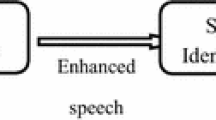Abstract
This paper presents a novel speech enhancement approach by combining Fourier series expansion and spectral subtraction. This approach is implemented in speaker identification systems where degraded speech could result in high false speaker identifications. A Fourier series is estimated for the noisy speech signals, and then spectral subtraction is used to reduce the amount of noise in order to enhance quality of the speech signals before the speaker identification process. Experimental results presented to compare between the proposed approach and the traditional methods demonstrate the ability of the proposed approach to both enhance speech quality and improve speaker recognition rates.









Similar content being viewed by others
References
Mavaddaty, S., Ahadi, S. M., & Seyedin, S. (2016). A novel speech enhancement method by learnable sparse and low-rank decomposition and domain adaptation. Speech Communication, 76, 42–60.
Kamath, S., & Loizou, P. (2002). A multi-band spectral subtraction method for enhancing speech corrupted by colored noise. In IEEE international conference on acoustics, speech and signal processing, p. 4164.
El-Samie, F. E. A. (2011). Information security for automatic speaker identification. New York: Springer.
Scalart, P., & Filho, J. (1996). Speech enhancement based on a priori signal to noise estimation. In IEEE international conference on acoustics, speech and signal processing, pp. 629–632.
Lu, Y., & Loizou, P. (2008). A geometric approach to spectral subtraction. Speech Communication, 50, 453–466.
El-Fattah, M. A. A., Dessouky, M. I., Diab, S. M., & El-Samie, F. E. A. (2008). Speech enhancement using an adaptive wiener filtering approach. Progress in Electromagnetics Research, 4, 167–184.
Osgood, B. (2013). Lecture notes for EE 261: The Fourier transform and its applications. Stanford University.
Reynolds, D., & Rose, R. (1995). Robust text-independent speaker identification using Gaussian mixture speaker models. IEEE Transactions on Speech and Audio Processing, 3, 72–83.
Kurzekar, P., Deshmukh, R., Waghmare, V., & Shrishrimal, P. (2014). A comparative study of feature extraction techniques for speech recognition system. IJIRSET, 3, 18006–18016.
Linde, Y., Buzo, A., & Gray, R. M. (1980). An algorithm for vector quantizer design. IEEE Transactions on Communications, 28, 84–96.
ITU-T Test Signals for Telecommunication Systems. http://www.itu.int/net/itu-t/sigdb/genaudio/Pseries.htm.
Kondo, K. (2012). “Subjective quality measurement of speech”, signals and communication technology (pp. 7–20). Berlin, Heidelberg: Springer. https://doi.org/10.1007/978-3-642-27506-7_2.
Author information
Authors and Affiliations
Corresponding author
Additional information
Publisher's Note
Springer Nature remains neutral with regard to jurisdictional claims in published maps and institutional affiliations.
Rights and permissions
About this article
Cite this article
Siam, A.I., El-khobby, H.A., Elnaby, M.M.A. et al. A Novel Speech Enhancement Method Using Fourier Series Decomposition and Spectral Subtraction for Robust Speaker Identification. Wireless Pers Commun 108, 1055–1068 (2019). https://doi.org/10.1007/s11277-019-06453-4
Published:
Issue Date:
DOI: https://doi.org/10.1007/s11277-019-06453-4




